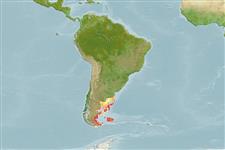Classification / Names
Common names from other countries
Main reference
आकार / वज़न / Age
Max length : 18.0 cm SL पुल्लिंग / अलिंग; (Ref. 188); common length : 15.0 cm SL पुल्लिंग / अलिंग; (Ref. 188)
पर्यावरण
; समुद्री; औशिनोड़िरोमस (Ref. 51243); गहराई सीमा 10 - ? m
जलवायु / सीमा
Subtropical, preferred 8°C (Ref. 107945); 38°S - 58°S, 70°W - 57°W (Ref. 188)
वितरण
Southwest Atlantic: 40°S to Tierra del Fuego and the Falkland Islands (Ref. 188), also Burdwood Bank (Ref. 27363). Records from the Pacific may refer to Strangomera.
देश | ऐफ ऐ ओ क्षेत्र | Ecosystems | संयोग | भूमिका
Short description
पृष्ठीय रीढ़ (सम्पूर्ण): 0; पृष्ठीय सौफट रेज़ (सम्पूर्ण): 13-21; गुदा कांटा 0; ऐनल सौफट रेज़: 12 - 23; जानवरों की रीड़ का जोड़: 52 - 58. Lower jaw slightly projecting, gill cover without bony radiating striae. Last two anal fin rays not enlarged. No dark spots on flanks. Pterotic bulla absent. Body dark blue dorsally and silvery white laterally and ventrally (Ref. 27363). All fins translucent (Ref. 27363).
IUCN Red List Status (Ref. 115185)
Threat to humans
Harmless
Human uses
मात्स्यिकी: व्यापारिक
अधिक जानकारी
सहयोगीयोतस्वीरेStamps, Coinsध्वनिसिगुयटिरारफ्तारतैरने के प्रकारगिल क्षेत्रOtolithsदिमागदृष्टि
साधन
Special reports
Download XML
इंटरनेट स्रोत
Estimates of some properties based on models
Phylogenetic diversity index
PD50 = 0.5312 many relatives (e.g. carps) 0.5 - 2.0 few relatives (e.g. lungfishes)
Trophic Level
2.6 ±0.26 se; Based on food items.
लौटाव
ऊंचा, न्यूनतम जनसंख्या दुगनी समय अवलागत 15 महीने। (K=0.7)
Vulnerability
Low vulnerability (14 of 100)
Price category
